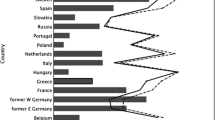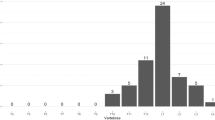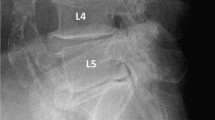Summary
□Background: The European Vertebral Osteoporosis Study (EVOS), a multinational muolticenter cross sectional study, was aimed to determine the prevalence of vertebral deformities, their risk factors and health impact.
□Methods: Between 1991 and 1993 4487 men and women aged 50 to 79 years were examined in 8 German study centres. Health impact, back pain and functional capacity were assessed in postal questionnaires. In medical interviews data was also collected on putative risk factors for osteoporosis including details on personal and medical history, drug use, diet, smoking, alcohol, exercise and gynaecological characteristics. Four thousand one hundred and twenty-two persons underwent a laternal X-ray examination of the thoracical and lumbar spine, representing a quarter of the 16 000 European participants.
Similar content being viewed by others
Literatur
Cooper C, O’Neill TW, Silman AJ. On behalf of the European Vertebral Osteoporosis Study Group. The Epidemiology of vertebral Fractures. Bone 1993; 14:S89-S97.
Eastell R, Cedel SL, Wahner HW, Riggs BL, Melton LJ. Classification of vertebral fractures. J Bone Miner Res 1991; 6:207–15.
Ford DE, Anthony JC, Nestadt GR, Romanoski AJ. The General Health Questionnaire by interview Performance in relation to recent use of health services. Medical Care 1989;7;367–75.
Jefferys M, Millard JB, Hyman M, Warren MD. A set of tests for measuring motor impairment in prevalence studies. J Chron Dis 1969; 22: 303–319
Kohlmann T, Bullinger M, Hunt SM, McKenna SP. Zur Messung von Dimensionen der subjektiven Gesundheit: Die deutsche Version des „Nottingham Health Profile“ (NHP). Lübeck 1992. Abreitsbericht
Kohlmann T, Raspe H. Der Funktionsfragebogen Hannover zur alltagsnahen Diagnostik der Funktionsbeeinträchtigung durch Rückenschmerzen (FFbH-R). Rehabilitation 1996; 35:I-VIII.
McCloskey EV, Spector TD, Eyres KS et al. Assessment of vertebral deformity — validation of a new method with high specifity. J Bone Miner Res 1992; 7S1:185.
Melton LJ, Lane AW, Cooper C, Eastell R, O’Fallon WM, Riggs BL. Prevalence and incidence of vertebral deformities. Osteoporosis Int 1993;3:113–9.
O’Neill TW, Cooper C, Cannata JB et al. Reproducibility of a questionnaire on risk factors for osteoporosis in a multicentre prevalence survey: The European Vertebral Osteoporosis Study. Int J Epidemiol 1994;23:559–65.
O’Neill TW, Varlow J, Felsenberg D et al. Variation in vertebral height ratios in population studies. J Bone Miner Res 1994;9:1895–907.
O’Neill TW, Cooper C, Algra D et al. Design and development of a questionnaire for use in a multicenter study of vertebral osteoporosis in Europe: The European Vertebral Osteoporosis Study (EVOS). Rheumatol Europe 1995;24:75–81.
O’Neill TW, Marsden D, Matthis C, Raspe H, Silman AJ and the European Vertebral Osteoporosis Study Group. Survey response rates: national and regional differences in a European multicentre study of vertebral osteoporosis. J Epidemiol Community Health 1995;49:87–93.
O’Neill TW, Felsenberg D, Varlow J, Cooper C, Kanis JA, Silman AJ. The Prevalence of Vertebral Deformity in European Men and Women: The European Vertebral Osteoporosis Study. J Bone Miner Res 1996; 11:1010–7.
Oswald WD, Fleischmann UM. Nürnberger-Alters-Inventar (NAI), 3. Aufl. Hofgrefe Verlag für Psychologie, Stuttgart 1995.
Richter H, Beuker F. Komplextest zur Ermittlung des physischen Leistungsvermögens. Theorie und Praxis der Körperkultur 1968;17:54–64.
Silman AJ and the European Vertebral Osteoporosis Study Group. The European Vertebral Osteoporosis Study (EVOS). In: Christiansen C, Riis B, eds. Osteoporosis. Proceedings 1993. Fourth international symposium on osteoporosis and consensus development conference. Osteopress, Rodovre (Denmark) 1993:65–6.
Tinetti ME. Performance-oriented assessment of mobility problems in elderly patients. J Am Geriatric Soc 1986;34:119–26.
Weiss N, Werle J, Rieder H, Weyerer S. Entwicklung und Reliabilität eines Sportmotoriktests für ältere Menschen. Motopäde 1989;3:27–8.
Weyerer S, Geiger-Kabisch C, Denzinger R, Pfeifer-Kurda M. Die Deutsche Version der CES-D Skala. Ein geeignetes Instrument zur Erfassung von Depressionen bei älteren Menschen? Diagnostica 1992;38:354–65.
Wieland EU, Felsenberg D, Kalender W, Kalidis L. The manual assessment of vertebral deformities in an epidemiological study. J Bone Miner Res 1993;8:352.
Author information
Authors and Affiliations
Rights and permissions
About this article
Cite this article
Raspe, A., Matthis, C., Scheidt-Nave, C. et al. Die eurpäische Studie zur vertebralen Osteoporose (EVOS): Design und Durchführung in acht deutschen Studienzentren. Med Klin 93 (Suppl 2), 12–18 (1998). https://doi.org/10.1007/BF03041993
Issue Date:
DOI: https://doi.org/10.1007/BF03041993




